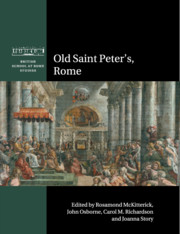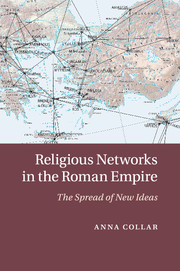Refine search
Actions for selected content:
23990 results in Ancient history
10 - Participants
-
- Book:
- State Pilgrims and Sacred Observers in Ancient Greece
- Published online:
- 18 December 2013
- Print publication:
- 19 December 2013, pp 156-173
-
- Chapter
- Export citation
Tables
-
- Book:
- State Pilgrims and Sacred Observers in Ancient Greece
- Published online:
- 18 December 2013
- Print publication:
- 19 December 2013, pp xiii-xiv
-
- Chapter
- Export citation

Old Saint Peter's, Rome
-
- Published online:
- 18 December 2013
- Print publication:
- 07 November 2013

State Pilgrims and Sacred Observers in Ancient Greece
- A Study of Theōriā and Theōroi
-
- Published online:
- 18 December 2013
- Print publication:
- 19 December 2013

Religious Networks in the Roman Empire
- The Spread of New Ideas
-
- Published online:
- 18 December 2013
- Print publication:
- 12 December 2013
Contents
-
- Book:
- Herodotus: Histories Book V
- Published online:
- 16 October 2018
- Print publication:
- 12 December 2013, pp v-v
-
- Chapter
- Export citation
Frontmatter
-
- Book:
- Herodotus: Histories Book V
- Published online:
- 16 October 2018
- Print publication:
- 12 December 2013, pp i-iv
-
- Chapter
- Export citation
Commentary
-
- Book:
- Herodotus: Histories Book V
- Published online:
- 16 October 2018
- Print publication:
- 12 December 2013, pp 93-311
-
- Chapter
- Export citation
Figures and maps
-
- Book:
- Religious Networks in the Roman Empire
- Published online:
- 18 December 2013
- Print publication:
- 12 December 2013, pp vi-vii
-
- Chapter
- Export citation
Religious Networks in the Roman Empire - Half title page
-
- Book:
- Religious Networks in the Roman Empire
- Published online:
- 18 December 2013
- Print publication:
- 12 December 2013, pp i-ii
-
- Chapter
- Export citation
Chapter Three - Jupiter Dolichenus: military networks on the edges of empire
-
- Book:
- Religious Networks in the Roman Empire
- Published online:
- 18 December 2013
- Print publication:
- 12 December 2013, pp 79-145
-
- Chapter
- Export citation
Maps
-
- Book:
- Herodotus: Histories Book V
- Published online:
- 16 October 2018
- Print publication:
- 12 December 2013, pp xiv-xxii
-
- Chapter
- Export citation
Chapter Two - Networks and religion in the Roman world
-
- Book:
- Religious Networks in the Roman Empire
- Published online:
- 18 December 2013
- Print publication:
- 12 December 2013, pp 40-78
-
- Chapter
- Export citation
List of Abbreviations
-
- Book:
- Herodotus: Histories Book V
- Published online:
- 16 October 2018
- Print publication:
- 12 December 2013, pp ix-xiii
-
- Chapter
- Export citation
Chapter One - The network approach
-
- Book:
- Religious Networks in the Roman Empire
- Published online:
- 18 December 2013
- Print publication:
- 12 December 2013, pp 5-39
-
- Chapter
- Export citation
Index
-
- Book:
- Religious Networks in the Roman Empire
- Published online:
- 18 December 2013
- Print publication:
- 12 December 2013, pp 316-322
-
- Chapter
- Export citation
Conclusions
-
- Book:
- Religious Networks in the Roman Empire
- Published online:
- 18 December 2013
- Print publication:
- 12 December 2013, pp 287-291
-
- Chapter
- Export citation
Works Cited
-
- Book:
- Herodotus: Histories Book V
- Published online:
- 16 October 2018
- Print publication:
- 12 December 2013, pp 312-338
-
- Chapter
- Export citation
Bibliography
-
- Book:
- Religious Networks in the Roman Empire
- Published online:
- 18 December 2013
- Print publication:
- 12 December 2013, pp 292-315
-
- Chapter
- Export citation
Contents
-
- Book:
- Religious Networks in the Roman Empire
- Published online:
- 18 December 2013
- Print publication:
- 12 December 2013, pp v-v
-
- Chapter
- Export citation
